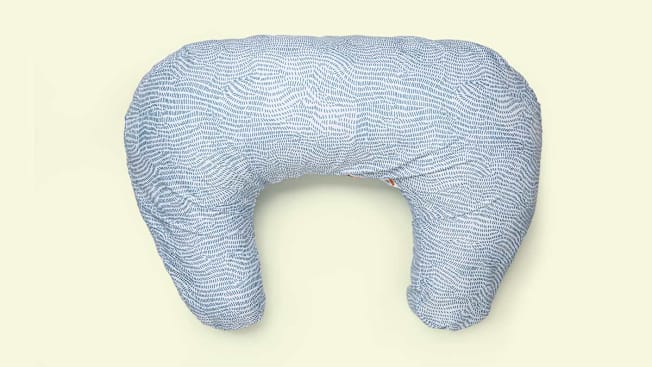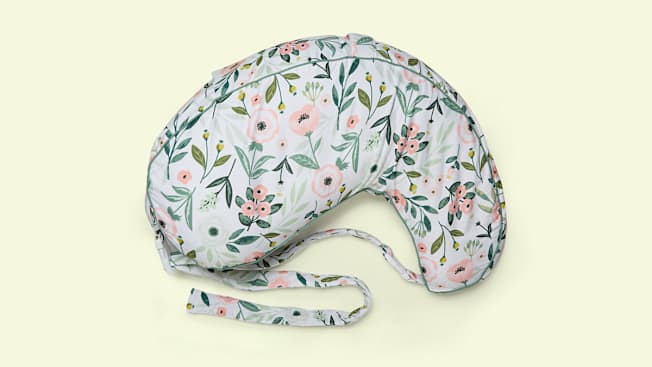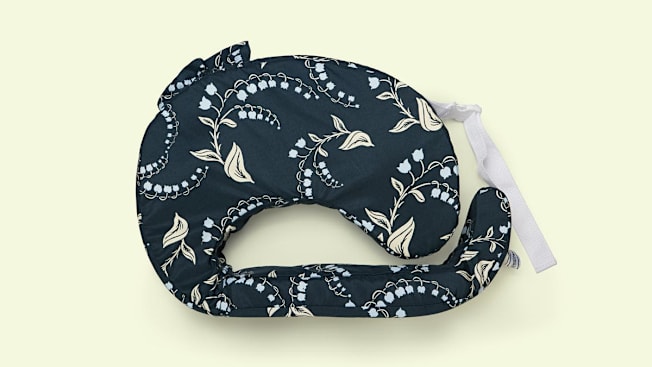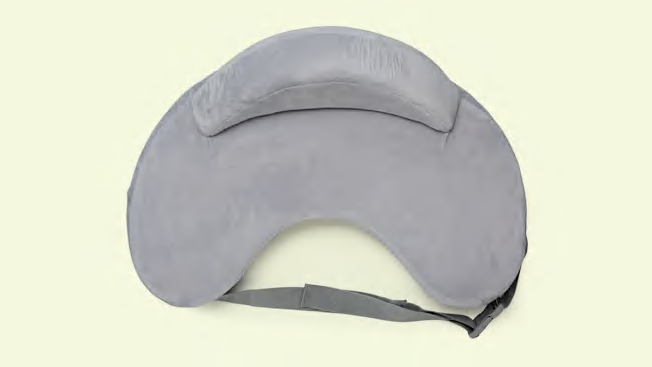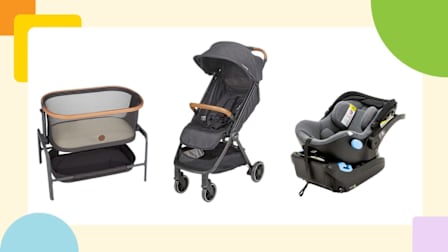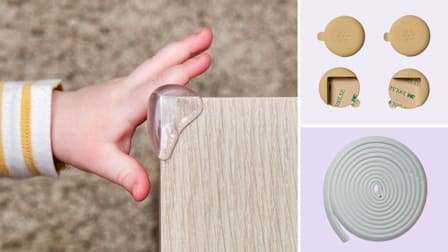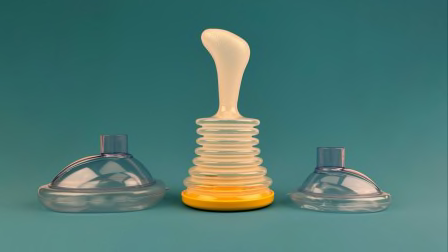How to Choose a Nursing Pillow and Use It Safely
Cutting through the confusion about a vital tool for the newborn months
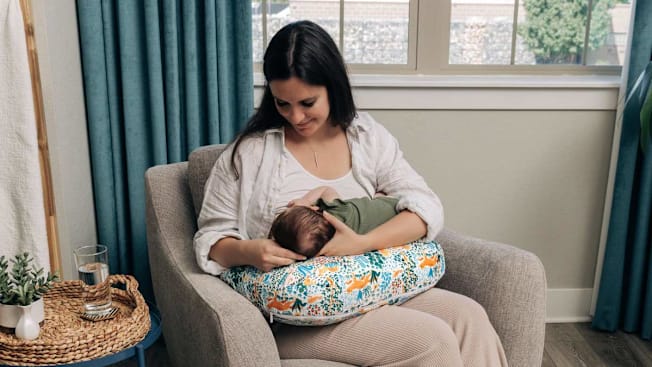
A nursing pillow is a staple on many baby registries—and for good reason. I can personally attest to carrying mine with me just about everywhere in those early months with a new baby. Newborns can eat as often as every one or two hours, day and night, and a good pillow helps your baby rest comfortably at just the right height while helping you avoid a sore back and shoulders. The extra support during feeding sessions can make breastfeeding and bottle-feeding much easier for mom and baby.
However, nursing pillows have been associated with dangers, especially when used for sleep, for propping babies up, or for purposes other than breastfeeding or bottle-feeding. Between 2010 and 2022, nursing pillows were involved in over 150 infant deaths, and previous investigations by Consumer Reports and others have highlighted the potential dangers of nursing pillows.
What Is a Nursing Pillow? Do You Need One?
A nursing pillow is a firm pillow that wraps around the parent’s body and sits comfortably around their middle section while seated. The baby lies on the pillow, which positions them closer to the breasts than if a parent were not using one, and the pillow supports the mother’s arms during the feeding session. Nursing pillows come in a range of sizes, styles, fabrics, and colors.
“For many women, they’re a must. Nursing pillows can take a lot of physical stress off a mom’s body during feeding, especially in those early weeks when everything is new and we’re feeding around the clock,” Hunter says. “They help lift the baby to a more comfortable height so we’re not curling forward or trying to hold the baby’s head up for long periods. That alone can make nursing more sustainable and less painful. So no, it’s not just another gadget—it can be a real game-changer when used the right way.”
And nursing pillows aren’t only for breastfeeding. Many parents who bottle-feed their babies enjoy the support and closeness that a nursing pillow can provide. If you’re combination-feeding your baby—that is, doing a mix of both breastfeeding and bottle-feeding—your nursing pillow can also be a helpful part of your feeding routine, whether your baby is feeding from the breast or the bottle.
That said, nursing pillows aren’t a requirement for successful breastfeeding, and parents have been breastfeeding for centuries before pillows were invented. What’s most important is for you and your baby to find a comfortable, safe feeding position where you feel supported.
How to Shop for a Nursing Pillow
In the past, choosing a nursing pillow simply meant picking your favorite pattern and shape. Now, however, parents should take a close look to make sure the nursing pillow they select is up to date with the latest safety regulations. Here’s what Consumer Reports safety experts say to look for:
Firm, flat cushion: New firmness standards require nursing pillows to be sufficiently firm to prevent accidental infant suffocation, and flatter in design to prevent use as an infant lounger. You’ll probably notice that nursing pillows that meet the new standard are a lot less squishy than the average pillow, and that’s by design.
Wide opening: Many nursing pillows are U-shaped with “arms” that extend around your middle. These arms should be wide-spaced so that the pillow fits around an adult’s waist, as they are designed to do, rather than to prop up an infant.
No straps for baby: No restraint straps for baby are allowed, which is meant to discourage using a nursing pillow as a place to leave a baby unattended, but secure straps to allow a better fit for the nursing parent are still okay.
Warning labels: Clear warning labels on the packaging and on the product itself are required to remind parents about the hazards of misuse and urge them not to use the pillow for infant sleep or to prop up a baby.
Hunter is a big fan of the changes to nursing pillow designs. “I think the updates are fantastic. Anything that encourages parents to use these products properly—and reminds them of what they’re not intended for—is a win,” she says. “The clearer labeling and design changes help reduce confusion and make it less likely that someone might mistakenly use the pillow as a sleep solution. It’s about awareness and prevention, and these changes help move us in the right direction.”
How to Use a Nursing Pillow
Babies don’t come with an instruction manual, especially not for breastfeeding, which can be a highly individualized experience. It’s okay if the first few times using a nursing pillow feel a bit awkward. Here’s how to use a nursing pillow safely.
Do’s
- Read and follow all instructions and warnings on your specific product.
- A few advance “practice runs” without the baby can be helpful—try positioning the pillow around your body and adjusting the straps (if any) to get the hang of it before you’ve got a hungry newborn eager to be fed.
- Don’t stress if you aren’t sure what positions are best the first few times. Finding the right feeding position is often a process of trial and error—your care provider or a lactation consultant can help.
If your baby is close enough to your own face that you could kiss them as they feed, they’re most likely in the right spot.
Pediatrician, lactation consultant, and AAP fellow
Dr. Clara Chlon, a board-certified pediatrician and newborn hospitalist for Cincinnati Children’s Hospital, a certified lactation consultant, and a fellow of the American Academy of Pediatrics, uses the rule “close enough to kiss” when it comes to positioning your baby on the nursing pillow: If your baby is close enough to your own face that you could kiss them as they feed, they’re most likely in the right spot. This simple rule also serves as a helpful reminder to only use the nursing pillow when you’re “close enough to kiss” and can provide direct support and supervision—never leave your baby propped up on a nursing pillow without you.
Don’ts
- Don’t use your nursing pillow for sleep, and don’t prop your baby up on the pillow. “The safety risks arise when the pillows are used for something other than their intended purpose,” Chlon says, “such as propping, lying, or placing babies to sleep on pillows unsupervised.”
- Don’t take a nap while holding your baby in your lap on the nursing pillow. “I recommend that families keep an eye on each other and support one another, because caring for an infant and keeping them safe is exhausting and truly takes a village,” Chlon says. “When used properly by a parent who is awake and not drowsy, a nursing pillow can remain a useful tool to make nursing more comfortable for both mother and baby.”
- Don’t carry a baby inside or on a nursing pillow. “It’s easy to underestimate how quickly a baby’s position can shift, especially when the pillow’s shape makes it seem secure,” says Hunter. “So always use when awake and never place them on elevated surfaces.”
- Don’t use a nursing pillow manufactured before April 23, 2025. While the new safety requirements only apply to nursing pillows made after this date, products manufactured prior to this date can still be available for sale online or secondhand. That’s why it’s important to check to make sure your nursing pillow is designed to meet the most up-to-date specifications, for your baby’s comfort and safety. (For all nursing pillows made after the new regulations went into effect, the manufacture month and year can be found on the product label, along with model and contact information for the manufacturer.)
Pro Tips From a Nursing Mom of Five
As a longtime nursing parent, I’ve used my fair share of nursing pillows. Here’s what I’ve learned along the way:
- Your bestie’s favorite pillow might not be your favorite. Order a few and keep the receipt and tags to return the ones you don’t love. Just like trying on swimsuits, it can be a very personal decision.
- Try a few different positions before judging a nursing pillow as “helpful” or “pointless”—sometimes, it’s the baby’s position, not the pillow, that needs adjusting.
- Shove that pillow way in close to your body, so there’s no gap between your torso and the pillow. The baby can slide into that gap, which defeats the point of the pillow supporting the baby.
- If you start to get drowsy, get help—get your partner or friend involved, and make sure they wake you up or take over if you are conking out. Sometimes nursing pillows take the weight off completely, and you get too comfortable!
- Choose a nursing pillow with a washable cover, and buy an extra cover for when yours is in the wash. Feeding a baby can be a messy job!
- If you can, get two nursing pillows—I kept one in my car for the first few months, so I didn’t have to transport mine and could be comfortable nursing on the go. I even took mine to restaurants and my older kids’ sports events. You might also like keeping one downstairs and one upstairs, or in two separate locations where you commonly feed your baby.
Safest Nursing Pillows
After ordering and evaluating seven of the most popular new nursing pillows available after the new regulations took effect, we recommend these.
Boppy
Just as Kleenex has become synonymous with tissues and Q-Tips have become the name for cotton swabs, some parents are so loyal to their Boppy that they simply call all nursing pillows “boppys.”
With the New Nursing Pillow (shown below), Boppy has updated the model they’d been using for three decades to comply with new regulations. “Boppy took its iconic shape, kept everything parents loved—like its machine-washable cover, its comfort and quality—and made it firmer, more supportive, loftier for a better latch and an easier fit for all body types,” according to a press release from the company.
Changes to the design include a wider opening, firmer cushion, new shape, and larger surface area. In Consumer Reports’ independent evaluation, the new product meets our safety criteria based on the latest regulations and is a safe, supportive choice.
Boppy New Nursing Pillow
Available at Amazon, Babylist, Boppy, Target, Walmart
Boppy also offers a smaller pillow called Uplift (shown below) for those wanting a smaller, portable option. In our evaluation, we noted that the length of the strap could theoretically pose a strangulation risk if a baby is left near the pillow unattended. It’s important to remember that nursing pillows should never be used to prop up a baby, and never to leave a baby unattended with a nursing pillow (Boppy’s instructions make it clear to never leave a child unattended).
Boppy Uplift Nursing Pillow
Available at Amazon, Babylist, Boppy, Target, Walmart
My Brest Friend
The Original nursing pillow (shown below) and the Deluxe nursing pillow from My Brest Friend “did not require redesign to meet the new compliance,” according to Erica Estrada, chief operating officer for Zenoff Products, wholesaler of My Brest Friend Nursing Pillows in California.
“The firmness, the right angles, the way it is wearable and fits securely to the mom’s body, and how the opening works, prevent the pillow from being used potentially erroneously,” says Estrada. “Our pillows are designed based on utility and support for successful breastfeeding.”
The newly required warning labels were sewn into all of their products, she adds, and the twin version of the nursing pillow was changed to make the opening wider and shallower.
The My Brest Friend is recommended by lactation consultant Mina Ognjanovic Jasovic, MHA, IBCLC, PMH-C, of UCLA and Providence Cedars-Sinai, who notes that she has seen this particular pillow “contribute significantly to parent confidence, sustained latch quality, and reduced physical fatigue—all of which promote breastfeeding duration and success.”
“I recommend My Brest Friend because of its firm, flat surface, which promotes optimal infant alignment and stability at the breast. Unlike softer pillows, which often allow the baby to roll or slump, compromising latch and safety, My Brest Friend provides a level, supportive base that positions the baby securely at breast height,” she says. “This is especially important during the early postpartum period when mothers are learning how to position and latch effectively.”
Jasovic also admires the adjustable strap, calling it a “critical” feature. “It allows the pillow to conform snugly to a wide range of body types and postpartum body changes. This adjustability eliminates the common issue of babies sliding between the pillow and the parent’s body, which I frequently observe with other models,” she says. “A snug fit also reduces maternal muscle strain and improves ergonomic support, particularly for parents recovering from cesarean birth or experiencing carpal tunnel syndrome.”
In Consumer Reports’ independent evaluation, our expert made a few notes about the visibility of the warning labels but noted that otherwise, the product design meets our safety criteria based on the new safety requirements and is a safe and supportive choice for parents.
My Brest Friend Original Nursing Pillow
Available at Amazon, Babylist, My Brest Friend, Target, Walmart
MomCozy
The MomCozy MaxSupport Nursing Pillow (shown below) was recently redesigned to comply with new safety regulations. They switched their filling to a new memory foam-based pillow to make it more comfortable and compliant, says Eden Cali, Global PR Manager at MomCozy. In addition, they updated the inner curve of the pillow and the arm length to meet the new sizing specifications. Finally, they added a safety measure on the adjustable waist strap that prevents it from being “tightened excessively, preventing any risk of encircling the baby,” Cali says.
One of the differentiating features of the MomCozy pillow is a safety barrier, which another spokesperson, Elena Martinez, explains is “designed to help keep baby from rolling off during nursing. “When used properly, the barrier sits behind the baby’s head, not near their face, so there’s no suffocation risk,” she says. The safety barrier might be particularly useful if you find yourself wanting more support, or your arm gets tired holding the baby close to you on the pillow. The pillow also has a removable cover for easy washing.
According to Consumer Reports’ expert evaluation, the MomCozy pillow is up-to-date, supportive, and safe.
MomCozy MaxSupport Nursing Pillow
Available at Amazon, MomCozy
Other Nursing Pillows We Evaluated
Leachco
The Natural Nursing Pillow by Leachco (shown below) is an interesting alternative to other products that have more of a curved “C” shape around the caregiver’s body. Instead, the Leachco option looks more like a little table, with contours on the edge wrapping around the edges of the parent. This could be attractive to parents who want their baby to have a larger surface, or don’t want to feel like a pillow is wrapped around their sides. In Consumer Reports’ evaluation, the pillow is a supportive and up-to-date option. Leachco did not respond to requests for comment.
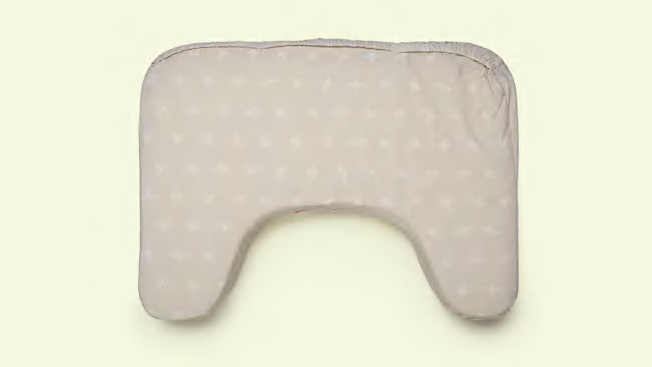
Photo: Scott Meadows/Consumer Reports Photo: Scott Meadows/Consumer Reports
Frida
Frida’s adjustable nursing pillow (shown below) met most of our safety criteria based on the new safety requirements, according to our independent evaluation. The product comes with three inserts that allow parents to change the firmness of the pillow, with two firm, molded foam inserts for younger babies, and one softer insert for older babies. But our expert wasn’t sure how the cover would fit with just one insert in, or what to do with the other parts when they aren’t in use.
According to our evaluation, the product warnings were hard to see through the packaging, and we couldn’t find some of the product information we were looking for on the label, such as the manufacture date. The product design meets our safety criteria based on the new safety requirements. FridaMom declined to comment on their product updates.
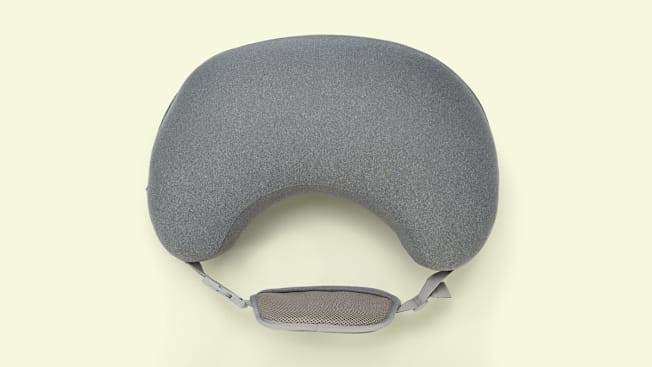
Photo: Scott Meadows/Consumer Reports Photo: Scott Meadows/Consumer Reports
Dream on Me
The Dream On Me Beeboo Nursing Pillow and Positioner (shown below) is available on Amazon, and the sample we purchased had a manufacture date of August 2024. While it’s legal to sell and buy nursing pillows manufactured before April 23, 2025, this pillow does not meet the updated safety requirements and is not recommended for use by our safety experts. The concerns are that the pillow is not firm enough to prevent potential suffocation and the opening is not wide enough to prevent potential entrapment if used as an infant lounger. The pillow also lacks the newly required warning labels and instructions.
Dream on Me didn’t respond to requests for comment and more information from Consumer Reports.
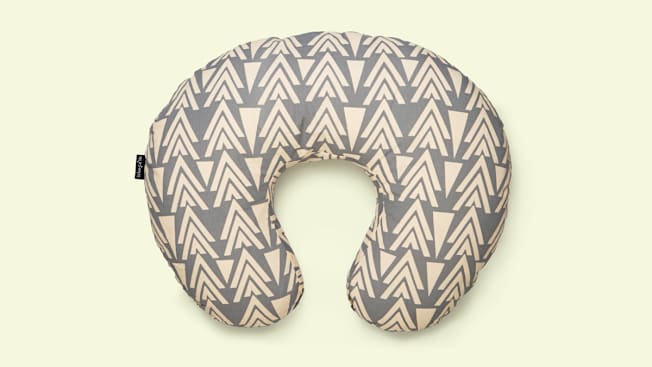
Photo: Scott Meadows/Consumer Reports Photo: Scott Meadows/Consumer Reports
Safe Sleep Guidelines for Infants
While nursing pillows can be essential support for new moms, they are never to be used for sleep. Here are the key safe sleep guidelines for babies.
- Always place your baby down on their back in their own sleeping space, with no other people or pets.
- Always use a crib, bassinet, or portable play yard for sleep with a firm, flat mattress.
- Only use a fitted sheet in your baby’s sleeping space.
- Do not put loose blankets, pillows or nursing pillows, stuffed toys, bumpers, baby loungers, or sleep positioners in your baby’s sleeping space.
- Do not use weighted sleep sacks.
- If your baby falls asleep in a car seat, stroller, swing, or infant carrier, move them to a firm sleep surface on their back as soon as possible.
Sudden Unexpected Infant Death (SUID), which includes Sudden Infant Death Syndrome (SIDS), remains among the leading causes of death in infancy. But following safe sleep practices for every nap and nighttime can help keep your infant safe and prevent the risk of SUID fatalities. For more safe sleep recommendations, reach out to your pediatrician.

















